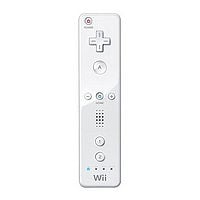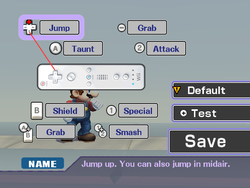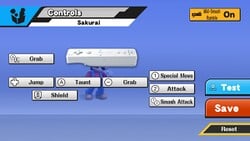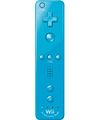Wii Remote
The Wii Remote, also nicknamed "Wiimote", is the primary controller for Nintendo's Wii console. The main features of the Wii Remote are its motion sensing capability, which allows the user to interact with and manipulate items on screen via movement and pointing, and its expandability through the use of attachments. In 2009, the Wii MotionPlus, an accessory that enhanced the controller's motion capabilities, was released, and in 2010, the Wii Remote Plus was released, which featured the accessory installed inside the Remote; Smash does not use Wii MotionPlus in any way.
The Wii Remote is a controller for Super Smash Bros. Brawl and Super Smash Bros. for Wii U. It can either be turned sideways, like an NES controller, or be playable with the Nunchuk accessory.
Whenever one selects a character while using a Wii Remote, Nunchuk or Classic Controller in Brawl, the character they selected will deliver a line through the Wii Remote's speaker, such as Mario saying, "Here we go!".
Compatibility[edit]
The Wii Remote is a compatible controller for Brawl. It can either be turned sideways, like an NES controller, or be playable with the Nunchuk accessory. The Wii Remote is also required to use the Classic Controller by plugging said controller into the bottom port of the Wii Remote. The Wii Remote and all of its configurations returned as a compatible controller for for Wii U. However, the Wii Remote was dropped as a compatible controller for the Nintendo Switch, and thus it and all of its configurations are not available for Super Smash Bros. Ultimate.
In Brawl and for Wii U, the buttons on the Wii Remote can be remapped in the Controls menu to perform other functions.
Standard controls[edit]
Note: From the perspective of the Wii Remote held sideways, with control pad on the player's left side.
| Jump | |
| Crouch | |
| Platform Drop | |
| Walk | |
| Dash | |
| Special Attack | |
| Standard Attack | |
| Smash attack | |
| Hold direction + |
Strong attack |
| Shield | |
| Up taunt | |
| Down taunt | |
| Side taunt | |
| Grab | |
| Home Menu |
Note: Because there is no way to avoid jumping when pressing Up for this control scheme, and tap jump cannot be turned off due to the lack of other jump buttons, the only way to use an up tilt is to be holding up while doing some other action.
Wii Remote and Nunchuk[edit]
Technical data[edit]
Input lag[edit]
When used for the Wii, the Wii Remote has fairly high latency, experiencing lows of 76.08ms (4.5 frames) and highs of 94.41ms (5.5 frames). The Wii U significantly reduces this, with the remote instead experiencing lows of 66.2ms (3.9 frames) and highs of 84.53ms (5.1 frames), making it a whole frame faster overall.[1] Overall, it is the fastest controller when used with Brawl and Smash 4, beating out the GCN by a few milliseconds. However, the inconsistency of the controller itself, the button formation, and being subject to battery life makes it the most unpopular control scheme for Smash.
Add-ons[edit]
Nunchuk[edit]
Released alongside the launch of the Wii and plugs into the bottom port of the Wii Remote. Adds a Control stick, a C button, and a Z button for additional flexibility in control schemes.
Classic Controller[edit]
Released alongside the launch of the Wii and plugs into the bottom port of the Wii Remote. Designed as an alternative to the Wii Remote with a more industry standard layout. Nintendo later updated the design with the Classic Controller Pro in 2009 that introduced two thighs for a more comfortable grip.
Wii Motion Plus[edit]
Released in 2009 and plugs into the bottom port of the Wii Remote. Adds a more sensitive and complex gyroscope for more demanding motion controls the original remote was not designed for. Came packaged with a special case that slips over the entire Wii Remote to make sure the attachment does not fall out.
Licensed variants[edit]
Wii Remote Plus[edit]
Released in 2010 and has the Wii Motion Plus hardware built into the remote itself, reducing its size to the original design. Eventually replaced the original design in stores, especially during the Wii U generation.
In competitive play[edit]
The Wii remote by itself is generally considered the worst official control scheme in the entire Smash series. This is primarily due to its lack of buttons making the controller heavily reliant on button macros and context sensitivity for basic inputs, which is not necessary with other controllers compatible with the same game. In particular, the lack of a Control stick causes inputting a dash to require a double press on the d-pad, as well as making tilt attacks, especially an up tilt, far more cumbersome to perform. Masahiro Sakurai himself admitted in a YouTube video that this configuration was not ideal due to its lack of a Control stick and reliance on a d-pad.[2] It being powered by AA batteries further dissuades players from using it, due to the hassles of needing to keep fully powered and spare batteries on hand, and unlike the Wii U Pro Controller, which has a much longer battery life on average, it cannot be readily charged. This control scheme is nearly non-existent in high-level tournaments, only seeing significant use in non-serious side events or self-imposed challenges.
Gallery[edit]
References[edit]
See also[edit]
| Controllers and buttons | |
|---|---|
| Nintendo 64 controller | |
| GameCube controller | |
| Wii Remote (and Nunchuk) | |
| Classic Controller | L |
| Nintendo 3DS | |
| Wii U GamePad / Pro Controller | L |
| Joy-Con | |
| Switch Pro Controller | L |
| Third-party controllers | Hori Mini Pad · Arcade controller · Keyboard |
| Other | Smash Controller · Controller modification |





